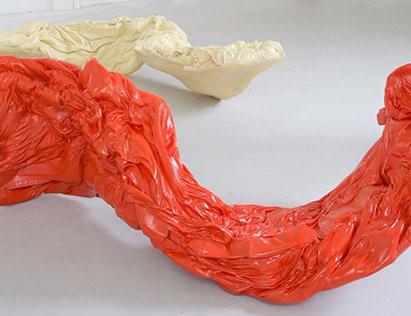The 2014 Christine Risley Award Winner
Article
Sophia Freeman, BA (Hons) Fine Art and History of Art graduate

The 2014 Christine Risley Award was awarded to BA (Hons) Fine Art and History of Art graduate Sophia Freeman. The judging panel agreed that her works demonstrate a sensual engagement with materials in a way which considers a tactile relationship between object and viewer.
Dealing with subtle transitions and shifts in materiality, Sophia Freeman likens her sculptural pieces to an image in the opening scenes of Claire Denis’s film ‘Trouble Every Day’, where the surface of the river Seine temporarily engulfs the screen.
‘As Saige Walton (2013) argues, during this brief moment the water is presented to us “as if it were a moving textile”. She notes that as the dissolves continue, the image retreats, revealing bridges and street lighting - thus locating the restless screen of fabric horizontally, the material texture implied by fabric subtly shifts to the substance of water’. Sophia Freeman (2014).
In the same way that Denis creates slippages between perceived image and actual substance, Sophia uses the process of casting to subvert the material identity of her sculptures. Latex is used as a skin within which to create plaster objects. These are then re-cast. Through a process of twisting and manipulating the mould, the backs of the original plaster pieces are revealed, allowing the soft folds of the front of the sculptures to take on a dynamic fluidity which gravity originally defied. The treatment of the surfaces with car paint further obscures the material of their origin. ‘…the outward appearance is in subtle discord with its brittle physical matter. I indented the ‘twist’ to create an allusion to lightness - as if the sculpture had been delicately posed - again, in dissonance with its materiality’. Sophia Freeman (2014).
The works may evoke visions of dirty mattresses, discarded sleeping bags or contorted bed linen, yet they remain autonomous in their identity. ‘Perhaps it’s because of their “lack” - or failure as definitively recognizable object-world things, that the works invite, as Laura Marks (2010) writes, a “haptic visuality” - a kind of “viewing which draws on other forms of sense experience (...) thus (being) a ‘tactile’ way of seeing and knowing which more directly involves the viewer’s body.”’ Sophia Freeman (2014).